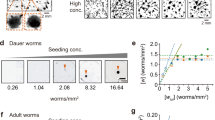Abstract
The classical chemostat models of Monod and others were designed for unicellular organisms. We summarize evidence that these models are not adequate for the rotifer chemostat, then propose a new, physiologically structured model that resolves some of their key problems yet remains biologically simple. The new model includes separate ontogenetic stages for eggs and free-swimming rotifers, with generalized age structure in the egg stage and body mass structure in the free-swimming stage. We present several numerical examples to illustrate the model's behavior, and we compare these in a preliminary way with experimental evidence from the literature.
Similar content being viewed by others
References
Bennett, W. N. & M. E. Boraas, 1989. Comparison of population dynamics between slow-and fast-growing strains of the rotifer Brachionus calyciflorus Pallas in continuous culture. Oecologia 81: 494–500.
Boraas, M. E., 1979. Dynamics of Nitrate, Algae, and Rotifers in Continuous Culture: Experiments and Model Simulations. Ph.D. thesis, Pennsylvania State University.
Boraas, M. E., 1983. Population dynamics of food-limited rotifers in two-stage chemostat culture. Limnol. Oceanogr. 28: 546–563.
Boraas, M. E., D. B. Seale, J. E. Boxhorn & J. N. McNair, 1998. Rotifer size distribution changes during transient phases in open cultures. Hydrobiologia 387/388 (Dev. Hydrobiol. 134): 477–482.
Herbert, D., 1958. Some principles of continuous culture. In G. Tunevall (ed.), Recent Progress in Microbiology. Blackwell, London: 381–396.
Monod, J., 1950. La technique de culture continue; theorie et applications. Ann. Inst. Pasteur, Lille 79: 390–410.
Rothaupt, K. O., 1993. Critical consideration of chemostat experiments. In N. Walz (ed.), Plankton Regulation Dynamics.Springer-Verlag, New York: 217–225.
Walz, N., 1993. Model simulations of continuous rotifer cultures. Hydrobiologia 255/256: 165–170.
Author information
Authors and Affiliations
Rights and permissions
About this article
Cite this article
McNair, J.N., Boraas, M.E. & Seale, D.B. Size-structure dynamics of the rotifer chemostat: a simple physiologically structured model. Hydrobiologia 387, 469–476 (1998). https://doi.org/10.1023/A:1017068528234
Issue Date:
DOI: https://doi.org/10.1023/A:1017068528234




